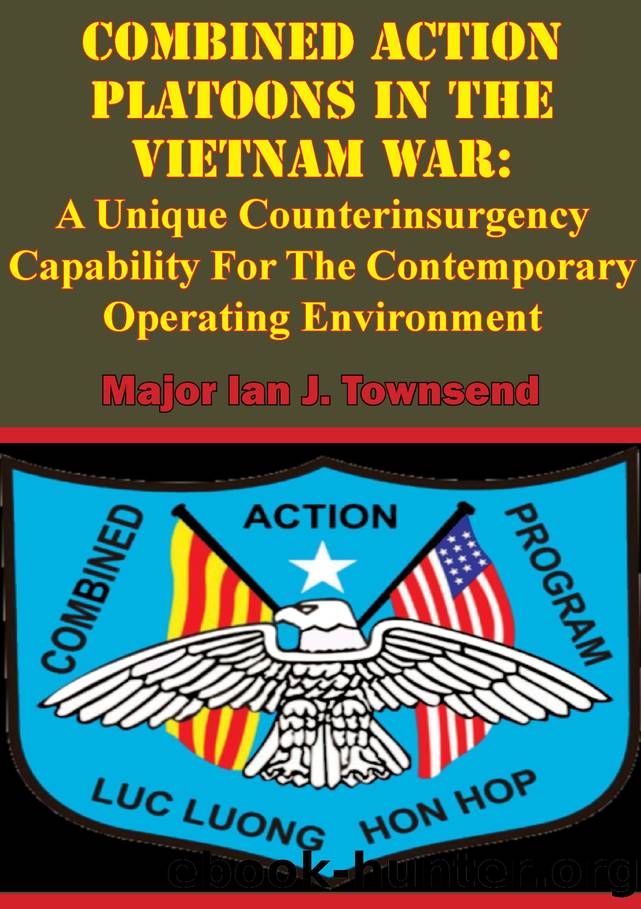Combined Action Platoons In the Vietnam War by Major Ian J. Townsend

Author:Major Ian J. Townsend
Language: eng
Format: epub
Publisher: Pickle Partners Publishing
Published: 2015-10-13T00:00:00+00:00
Figure 3. Counterinsurgency Lines of Effort.
Source: Department of the Army Field Manual 3â24.2 Tactics in Counterinsurgency. Support Host Nation Security Forces
General Waltâs campaign plan combined both a counterinsurgency operation against Viet Cong in the III MAF area of operation and an offensive operation against North Vietnamese main force units. Against the wishes of General Westmoreland, the decisive operation within his campaign plan was the counterinsurgency operation.{98} Within the four lines of effort of the counterinsurgency operation, the formalized CAP program became the primary tactic to achieve the support of the host-nation security forces line.
The first decisive point along this line of effort in Tactics in Counterinsurgency is to identify the indigenous security forces. At Phu Bai the Marines did this and benefited from the existence of the Popular Forces. The existence of the Popular Force organization before the Marineâs arrival in Vietnam is significant. Although the Popular Forces were pitiful by all reasonable standards, the fact that the Marineâs did not have to build a village security force created the conditions for the CAP program to take effect and to formally expand as a key tactic within the III MAF counterinsurgency campaign.{99} William Corson observed that the Popular Forces were the âmake or breakâ part of this campaign.{100} The III MAF counterinsurgency campaign would have been different or less successful without the formally established Popular Forces organization. This point is important for any counterinsurgency campaign planner to confirm and consider in their planning processâdoes an organized force within the local villages exist to conduct combined action with? Vietnam CAPs did not conduct combined action with regular ARVN forces. If a security force like the Popular Forces does not exist and U.S. Army forces are required to build a village/neighborhood force then a program such as CAP is not an option, or at least not as an option like III MAF Commander had in Vietnam.
In addition to the pre-existence of the Popular Force organization, a second uniqueness that the CAP program had in Vietnam as they identified the indigenous security forces was territorial. Where they operated mattered as much as which security forces the Marines combined with. The CAP program supported host-nation security forces in the hamlet and village, not the larger cities within the provinces. Providing American military resources to a force of men to defend two of their most valuable possessions, home and family, provides an economy of effort both mentally (the will of the host-nation defender is stronger when he fights for what he loves) and physically (a CAP program uses less American than host-nation forces). Any planner or commander considering replicating CAP in some form, if security force conditions make it feasible, needs to account for the significant value that combined action focused directly on defending peopleâs homes and livelihood has. Lieutenant Colonel Wagner states, âThe big thing about the popular force soldier is that he is recruited as a volunteer from the hamlet in which he will serve. This is the primary source of his motivation.
Download
This site does not store any files on its server. We only index and link to content provided by other sites. Please contact the content providers to delete copyright contents if any and email us, we'll remove relevant links or contents immediately.
The Radium Girls by Kate Moore(11935)
100 Deadly Skills by Clint Emerson(4845)
Rise and Kill First by Ronen Bergman(4706)
The Templars by Dan Jones(4630)
The Doomsday Machine by Daniel Ellsberg(4421)
The Rape of Nanking by Iris Chang(4141)
Killing England by Bill O'Reilly(3953)
Hitler in Los Angeles by Steven J. Ross(3902)
Stalin by Stephen Kotkin(3885)
12 Strong by Doug Stanton(3511)
Hitler's Monsters by Eric Kurlander(3270)
Blood and Sand by Alex Von Tunzelmann(3140)
The Code Book by Simon Singh(3078)
Darkest Hour by Anthony McCarten(3072)
The Art of War Visualized by Jessica Hagy(2945)
Hitler's Flying Saucers: A Guide to German Flying Discs of the Second World War by Stevens Henry(2716)
Babylon's Ark by Lawrence Anthony(2622)
The Second World Wars by Victor Davis Hanson(2485)
Tobruk by Peter Fitzsimons(2448)
